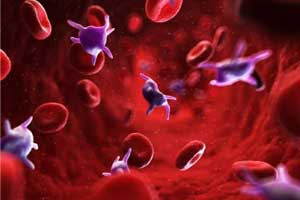- Home
- Editorial
- News
- Practice Guidelines
- Anesthesiology Guidelines
- Cancer Guidelines
- Cardiac Sciences Guidelines
- Critical Care Guidelines
- Dentistry Guidelines
- Dermatology Guidelines
- Diabetes and Endo Guidelines
- Diagnostics Guidelines
- ENT Guidelines
- Featured Practice Guidelines
- Gastroenterology Guidelines
- Geriatrics Guidelines
- Medicine Guidelines
- Nephrology Guidelines
- Neurosciences Guidelines
- Obs and Gynae Guidelines
- Ophthalmology Guidelines
- Orthopaedics Guidelines
- Paediatrics Guidelines
- Psychiatry Guidelines
- Pulmonology Guidelines
- Radiology Guidelines
- Surgery Guidelines
- Urology Guidelines
Higher Prophylactic platelet transfusion threshold increases deaths in neonates

A new study published in NEJM reports that among preterm infants with severe thrombocytopenia, the use of a platelet-count threshold of 50,000 per cubic millimeter for prophylactic platelet transfusion resulted in a higher rate of death or major bleeding than a restrictive threshold of 25,000 per cubic millimeter within 28 days after randomization.
Platelet transfusions are commonly used to prevent bleeding in preterm infants with thrombocytopenia. Currently, there is no evidence to provide guidance regarding thresholds for prophylactic platelet transfusions in preterm neonates with severe thrombocytopenia.
Read Also: Fostamatinib has meaningful clinical response in Immune Thrombocytopenia
Anna Curley and associates performed a multicenter, randomized trial to assess whether a policy of prophylactic platelet transfusion in preterm infants, based on a platelet-count threshold of less than 50,000 per cubic millimeter, as compared with less than 25,000 per cubic millimeter, reduced the risk of death and major bleeding.
The authors randomly assigned a total of 660 infants (median birth weight, 740 g; and median gestational age, 26.6 weeks) born at less than 34 weeks of gestation in whom severe thrombocytopenia developed to receive a platelet transfusion at platelet-count thresholds of 50,000 per cubic millimeter (high-threshold group) or 25,000 per cubic millimeter (low-threshold group). Bleeding was documented prospectively with the use of a validated bleeding-assessment tool. The primary outcome was death or new major bleeding within 28 days after randomization.
The key study findings included are:
- In the high-threshold group, 90% of the infants (296 of 328 infants) received at least one platelet transfusion, as compared with 53% (177 of 331 infants) in the low-threshold group.
- A new major bleeding episode or death occurred in 26% of the infants (85 of 324) in the high-threshold group and in 19% (61 of 329) in the low-threshold group.
- There was no significant difference between the groups with respect to the rates of serious adverse events.
Read Also: Vitamin B12 deficiency linked to severe thrombocytopenia in Dengue
“Our trial highlights the importance of trials of platelet transfusion involving patients with conditions other than hematologic cancers. This large, multicenter, randomized trial involving preterm infants with severe thrombocytopenia showed that more deaths, major bleeding, or both occurred when a higher prophylactic platelet-count transfusion threshold of 50,000 per cubic millimeter was used than when a threshold of 25,000 per cubic millimeter was used,” write the authors.
For full information log on to https://www.nejm.org/doi/full/10.1056/NEJMoa1807320?query=main_nav_lg

Disclaimer: This site is primarily intended for healthcare professionals. Any content/information on this website does not replace the advice of medical and/or health professionals and should not be construed as medical/diagnostic advice/endorsement or prescription. Use of this site is subject to our terms of use, privacy policy, advertisement policy. © 2020 Minerva Medical Treatment Pvt Ltd